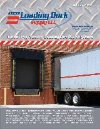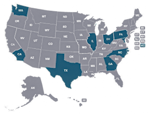Wedge Anchors
Wedge anchors—sometimes called expansion anchors—are tough, dependable fasteners perfect for attaching things to solid concrete. They're great for jobs that need real strength, like bolting down structural steel, heavy machinery, or safety rails. When done right, they hold firm and last.
Wedge Anchors - For installing dock bumpers to concrete dock structures.
Material: Zinc Plated
Size: 4 1/4" x 3/4"
Price $3.80 ea
Wedge anchors are shipped UPS seperatly from dock bumpers.
Material: Zinc Plated
Size: 6 1/4" x 3/4"Price $5.20 ea
Wedge anchors are shipped UPS seperatly from dock bumpers.
What's a Wedge Anchor?
At its core, a wedge anchor has a threaded rod, an expanding clip (that's the "wedge" part), a nut, and a washer. When you tighten the nut, it pulls the rod up, forcing the clip to spread out and grab the concrete walls. Skip them for brick, block, or anything hollow—they could crack or give way under pressure.
Tools and Materials You'll Need
Tools
- A hammer drill set to hammer-and-rotate mode
- Carbide-tipped masonry bit sized exactly for your anchor
- Torque wrench or a good adjustable wrench/socket
- Hammer for tapping
- Wire brush, shop vac, air blower, or dust collector to clear debris
- Tape measure, depth stop, or marked bit for accuracy
- Safety gear: Glasses, gloves, dust mask, and ear plugs
- For taking them out: Pliers, pry bar, some penetrating oil, and patching material like hydraulic cement or epoxy
Materials
- Wedge anchors—go zinc-plated for most jobs as it is an industry standard, galvanized or stainless steel if it's around moisture and chemicals.
- Matching nuts and washers (they usually come with the anchors)
Safety First: Key Tips to Stay Safe
- Always gear up with PPE to shield yourself from flying bits and dust.
- Keep your workspace tidy, steady, and airy—no clutter or stuffy spots.
- Handle the hammer drill with a solid grip; if you're drilling overhead, use extra support.
- Hold off on fresh concrete—give it at least a week to cure, or check its strength first.
- Stick to OSHA rules for tools and fastening to avoid mishaps.
Picking the Best Wedge Anchor for Your Job
- Size and Length: Match it to your load and what you're fastening. At minimum, length should cover the fixture thickness plus embedment depth plus the nut and washer.
- How Deep to Go: Bury it deeper for more holding power.
- Hole in Your Fixture: Make it a tad bigger than the anchor's diameter.
- Strength Rating: Think about steady vs. moving loads, and check the maker's charts for shear and tension.
- Spacing Rules: Keep anchors at least 10 times their diameter apart, and 5 times from any edge to dodge cracks.
Embedment Depth Chart
| Anchor Diameter |
Minimum Embedment Depth |
| 1/4" |
1-1/8" |
| 5/16" |
1-1/4" |
| 3/8" |
1-1/2" |
| 1/2" |
2-1/4" |
| 5/8" |
2-3/4" |
| 3/4" |
3-1/4" |
| 7/8" |
3-7/8" |
| 1" |
4-1/2" |
| 1-1/4" |
5-1/2" |
Fixture Hole Size Chart
| Anchor Diameter |
Minimum Fixture Hole Diameter |
| 1/4" |
5/16" |
| 3/8" |
7/16" |
| 1/2" |
9/16" |
| 5/8" |
3/4" |
| 3/4" |
7/8" |
| 7/8" |
1" |
| 1" |
1-1/8" |
| 1-1/4" |
1-3/8" |
Installation: Step by Step
- Get Ready and Mark: Measure out where the holes go and mark them clearly. Line up any fixture you're attaching.
- Drill: Grab your hammer drill and the right-sized carbide bit. Drill straight in, going about half an inch deeper than your embedment needs.
- Remove Debris: Scrub with a brush and suck or blow out the dust a couple of times—debris is the enemy here.
- Assemble wedge anchor: Slip on the washer and screw the nut until it's even with the top threads.
- Insert: Hammer the anchor through the fixture (or straight in) until it's sitting flush.
- Tighten Bolt: Turn the nut three or four times past snug, or hit the exact torque from the specs.
- Double-Check: Give it a tug to make sure it's solid and give it a light test.
Torque Specs
| Anchor Diameter |
Approximate Torque (ft-lbs) |
| 1/4" |
4–5 |
| 3/8" |
25–30 |
| 1/2" |
50–60 |
| 5/8" |
90–100 |
| 3/4" |
150–175 |
Don't Make These Common Slip-Ups
- Wrong bit size—too big means weak grip, too small and it won't fit.
- Forgetting to clean the hole—that can cut your hold by half.
- Trying them in anything but solid concrete, like brick—it won't work as intended.
- Not going deep enough or messing up the torque.
- Crowding anchors too close or near edges.
How to Remove a Wedge Anchor
Sometimes you gotta pull out a wedge anchor—for upkeep on your loading dock, moving gear, or swapping it out. They're not meant for constant reuse since the clip can bend out of shape, but you can get them out of solid concrete without too much hassle if you're careful not to wreck the surface. Here's how to do it right:
- Set Up Safe: Clear space around you and suit up with safety glasses, gloves, and a mask. Prop up any attached piece so it doesn't drop.
- Back Off the Nut: Grab a wrench or socket and spin the nut left to loosen it all the way. Pull off the nut and washer if you can, or keep them if it helps with the next step.
- Lube If It's Stubborn: For rusty ones (pretty common outside on docks), squirt some penetrating oil like WD-40 on the threads and wait 5–10 minutes to loosen things up.
- Tap It In: Lightly hammer the threaded end inward toward the concrete. This eases up the clip's hold. Go easy to avoid chipping the surface.
- Yank It Out: Use pliers or a pry bar on the rod to pull the anchor free. Bigger ones might need more muscle—tap and wiggle if it's fighting back.
- Fix the Hole: Brush out leftovers and fill with cement, epoxy, or patch mix for a flat finish. This is key on dock floors to stop trips or damage from gear. Let it cure as directed.
- Look It Over: Scan for cracks or chips in the concrete. If it's bad, talk to an engineer before putting in new anchors.
Trouble Spots and Fixes
- Won't Budge: Could be too tight or in tough concrete. More oil, harder taps, or a bigger hammer might help. Worst case, drill around it—but watch for damage.
- Spins Freely: If the rod turns while loosening, tap it in first to break the clip's grip, then pull.
- Rusty Mess: Outside anchors can corrode. Soak longer in oil or add a bit of heat if it's safe.
- Don't Reuse: Skip putting old ones back in important spots—the clip or threads might be shot, weakening the hold.
Quick Tip: On loading docks, make sure those filled holes are smooth and set before rolling forklifts over them—keeps things safe and up to OSHA specs.
Handy Tips for Success
- Drill a bit extra deep for even better grip.
- Opt for galvanized or stainless in wet environments.
- Try a test install first to get the feel.
- Keep anchors stored dry to fend off rust.
- For big jobs, run it by a structural engineer.
Why Go with Loading Dock Supply?
Here at Loading Dock Supply, we've got top-notch wedge anchors and all the gear you need for safe, smooth dock setups. Give us a ring at 1-800-741-1258 for tips or a custom quote—we're here to help.
Get a Quote Now
Quick Answers to Common Questions
What's the Least Embedment Depth?
Depends on the size—like 1-1/2" for a 3/8" anchor. Check the chart up top.
Work in Brick?
Nope, they're made for solid concrete only. Try sleeve anchors for hollow stuff.
Removal How-To?
Loosen the nut, lube if rusty, tap inward, pull with tools, and patch up. Details in the removal part above.
Back to Top
|





